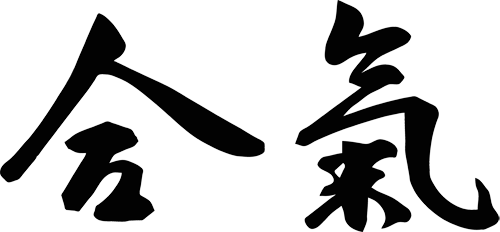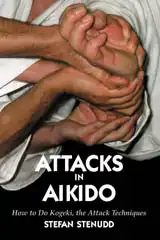Aiki — Joining EnergiesApplications of the Aiki Principle in Aikido
Here are aikido applications of the aiki principle. Joining instead of resisting is one of the core ideas of aikido. It shapes the techniques in so many ways. Ai and ki are, of course, the two first words of aikido. Ai means to join or fit, and ki is the life energy of old Japan and China (transcribed qi or chi from the Chinese). So, aikido is simply the way of joining ki.
 Aiki, joining energies, in kanji.
On this video I show a number of different applications of the aiki principle. Each one is explained in text as well. They are really just facets of one and the same gem, which means they all apply to any aikido technique. Well, most of those applications. Some are alternate solutions, different ways of doing the same technique. I mainly show the aiki applications rather slowly for clarity, but there are also some faster examples. Usually it’s gotai (from a static starting point). But there is also some jutai (moving as the attack approaches). Here are some words about each aiki application, in the same order as in the video:
Letting the attack throughThis is how every aikido technique should start — the evasive taisabaki move to let the attack through instead of trying to block or resist it. That's the prerequisite of applying aiki.
Leading the attack onAs you join with the direction of the attack, you also lead it on. You make it extend a little longer than the attacker intended, bringing him or her out of balance. Again, I think every aikido technique must include this. It's the strategic advantage of aiki: the attacker may expect resistance, but not the very opposite.
Redirecting the attackThis is when the specific aikido technique begins. Because you let the attack through and lead it on in an aiki manner, you can effortlessly redirect it into the aikido technique of your choice. Just about any direction will do — except right back at the attacker.
Spiral movementsSpirals hide in every aikido movement. Sometimes they are big and clearly visible, sometimes so small they go unnoticed by the attacker or the spectator. But they are always there. It's in their nature. It's also the type of movement that is the most difficult for the attacker to resist. In order to resist, the attacker must feel where a force originates and where it is heading. With spirals, that's almost impossible, when done flowing.
Extending the attack to bring it downWhen you extend the attack you can continue in just about any direction you want. Here it is done downwards, which applies to a number of aikido techniques, but far from all of them.
Returning to the attackerThis does not mean you allow the attacker to regain balance and control. Quite the opposite. By your roundabout aiki maneuvers, you bring back the power of the attack to the attacker in such a way that he or she falls by it. On could say that you sort of surround the attacker with his or her own force.
Immediate entryThis is one possible solution for several aikido techniques. At the same time as you let the attack through and extend it, you can enter and make the throw. This fast solution is particularly helpful in taninzugake, against several attackers.
Turn and returnThis is the simple method behind many aikido techniques. You turn to lead the attack on in an aiki manner, and then you return for the throw. This returning is not exactly in line with the attack. There is some redirection in between. But your body movement, turning and returning, gives you the power and rhythm needed.
Mirroring the attack to be out of reach (maai)In katatedori (wrist grab) and some other attack forms, it is possible to create a distance enough to stay out of reach for a follow-up attack. That distance is maai, where none can strike the other without advancing. Extend your hand towards the grip, proactively, with unbendable arm. This unexpected move will make the attacker sort of bounce back enough not to reach you with a strike. From that position you can redirect with aiki into an aikido technique.
Going up to go downAikido is full of paradoxes. If you want to bring the attacker down, you may need to bring him or her up first. That sort of unlocks the resistance against being pulled down. It also works reversed: go down to go up. And if you wave your hand up and down, you can get the attacker way out of balance.
Extended spirit, short moveYou must extend your spirit to make your aikido techniques work. When you do, your movements don't need to be big. It's the spirit of them that counts. If it's properly extended, the actual movement can be so small it's almost invisible and still have a big effect.
Returning through the attacker's center (tanden)When you have opened up the situation by accepting the attacker's direction of energy in aiki, you can return in a curve and bring the energy of the attack back sort of through the attacker's center (tanden) and to the floor. Like a wave returning from the shore. It's not enough to return it to the attacker's center, which would just make him or her stable and strong, but through it. The wave goes over and past the attacker.
Collapsing inwardsCollapsing inwards means bringing it all deep into your own center (tanden). It makes outside structures, such as that of the attacker's posture and grip, collapse. Since it is to your center, your own stability and capacity are unaffected, if not improved. Notice that you still have to start with the taisabaki evasive move and the aiki joining, or you just collide.
Extracting from the attacker's center (tanden)The energy of the attack originates in the attacker's center (tanden). Whatever technique you want to do, you should create it in a spirit of bringing it out from the attacker's center, as if it were on his or her initiative. That's aiki at work. If done well, it makes the attacker instinctively joining with the aikido technique — as if wishing it. Aikido techniques can't be done merely with the arms or body of the attacker. His or her core has to be involved.
Unlocking by extendingThe key to getting out of forceful grips is to extend in the direction of the attack, which is the line from the attacker's center (tanden) to you. Don't try to break free, but pull in line with the attack. There will be surprisingly little resistance.
Accelerating whirlsAikido movements are spirals within spirals. That's also the nature of ki, the energy. By moving in whirls, you utilize this spiral nature of things. There is a rhythm to it, as well. Constant speed is unnatural and weak. Acceleration (or deceleration) creates much more of an effect. Just about every kokyunage is a good example of this at work.
Extending by turningIt is important to use your whole body in your aikido techniques, and not just your arms or legs. Body turns (taisabaki) are very effective ways to bring power to your techniques. For example, even if you are held with great strength, you should be able to get free by turning your whole body to extend the energy. It's your whole body against just one arm or two of the attacker's grip. That should be enough.
Remaining centeredIn all budo, staying in your center (tanden) is fundamental. It also means you should as much as possible keep your arms in front of your center line, your body's vertical middle. It's very clear in the aikido technique shihonage, which is based on the Japanese sword arts. The movement in this throw is basically the same as when drawing and cutting with a two-handed sword. With the sword, staying centered is absolutely essential.
Changing contact hand smoothlyYou can't change contact hand with a jerk. That will cause an instinctive reaction in the attacker, which is both quick and forceful. You must be smooth about it, so that the attacker doesn't get alarmed. That's really true for all you do in aikido. The attacker should not get the feeling that it's a counter attack. If you can make your moves softly and sort of discreetly, the attacker will have the impression of everything going his or her way. That's the spirit of aiki.
Throwing gently, without ambitionAmbition is forceful intention, and every animal has a finely tuned instinct to notice and react to it. In order to succeed smoothly with your aikido techniques, you need to do them without ambition. Don't strive to defeat the attacker, but to guide him or her to a solution that is somehow most beneficial to both of you. Dare to be gentle, and you will be convincing. The gentler you can be, the more effective your aikido technique becomes. Really.
Tying up and releasingSeveral aikido techniques have the pattern of first tying up the attacker's arms as well as energy, and then releasing it all in the throw. If done elegantly, the attacker will feel the throw as liberating. The tying up is done in spirals, of course. In the release, the spirals open bigger, as does the flow of energy.
Shifting from vertical to diagonalThis is a great resource in aikido. Shifting from vertical to diagonal, the aikido technique finds its way easily. The problem is actually solved already by this change of direction. It's like the kesagiri cut of the Japanese sword arts. It finds its way through just about everything. The strange thing with this shift of directions is that when you do it, the attacker can't help but do it, too. It is ultimately contagious, because it speaks to instinct. When your perspective changes, the attacker's perspective has to do the same. It's automatic. Even from a distance.
Creating reaction before contact (sen no sen)When your movements speak to the attacker's instincts — and a lot of them can do just that — there will be a reaction, even from afar. That's how we are. It looks funny, but it really works, when used with distinction and proper timing. It has to come as a surprise, of course. Something unexpected, triggering an instinctive response, like a reflex. It is not easy to practice in a dojo, since it really needs the element of surprise, but you can feel it — also when you do it repeatedly. It needs a sincere attack done with an attacker state of mind. Sen no sen is an old budo expression meaning before — i.e. before the attacker reaches you. There is also a sen sen no sen, which is before the attack is even initiated. That's more tricky, but not impossible.
Creating wavesA static situation is easily loosened, because movement is what the whole universe is about. Waves are hiding in utter stillness, just waiting to be revealed and set free. When you go into the mood of creating waves, there is no holding you. The attacker will get sucked into the waves and enjoy it. That's the flow of life. Making the waves appear is no effort, but holding them back is. So, just go for it.
Extracting flow from calm contactThere is flow in stillness. Even when there is no attack, this flow can be made to emerge, as long as your partner focuses on you. As soon as you have his or her attention, there is a flow of intention emanating. You can bring it out by aiki, extend it and turn it into an aikido technique. This is both fun and inspiring to work with. You practice reading and using the subtle. And you learn to make your aikido so that it meets with no resistance. It just happens, to the delight of both.
Throwing by yieldingAs the Tao Te Ching tells us, there is great power in yielding. Anything can be overcome by yielding. The attack itself is transformed to something harmless, when it is met by delighted yielding. It takes the aggression out of the attacker, as if immediately washed away. Yielding is letting your own energy flow down, like water flows to the lowest place (as Lao Tzu put it). The attacker's energy will do the same. It's contagious. Nature is beautiful that way.
Settling by exhalingBreath is fundamental in life. We all have to do it. And it's closely related to the concept of ki. It is also very contagious. In close contact, we tend to copy the other one's breathing, making them unison. So, it can be used in aikido. Breathing in can cause worry, whereas breathing out calms you down. Aikido techniques should be done in the spirit of breathing out, so as to create calm and peacefulness also in the attacker. Even an aggressor yearns to join with the relaxation of exhaling. That in itself can lead to a peaceful conclusion, cherished by both.
Leading by subtle returningAiki flows can be quite subtle. It happens within the contact, within the dynamic relation between tori and uke (defender and attacker), whether or not there is an attack. You can receive your training partner's energy through the contact, as if breathing it in, and return it the same way, as if breathing it back out. If you stand still, this return will make your partner more stable and strong. That's nice, but not always your intention. If you make a slight taisabaki movement before breathing it back out, the change of circumstances will make uke fall. It looks odd, but if you try it you can sort of feel how it works. It's about how every living being wants to join with the flow.
AIKIDO PRACTICEIntroductionAikido Techniques — all the basic movesAttacks in Aikido
Tantodori — knife defenseAikiken — aikido sword techniquesJo 31 Kata in four directionsAikibatto sword and staff exercisesAiki — joining energiesKi exercisesAikido Video ClipsAikido PhotosMy aikido dojo in Malmö, SwedenMy aikido seminarsAIKIDO THEORYMy Aikido BioAikido GlossaryTanden, the CenterAikido InksAikido as Self-DefenseRunning a DojoAikido is TrueOsensei and EinsteinAikiWeb ColumnsAikido Books ReviewedDie deutsche Version meines Aikido-Buches onlineAikido på svenskaAbout CookiesMy Other WebsitesCREATION MYTHSMyths in general and myths of creation in particular.
TAOISMThe wisdom of Taoism and the Tao Te Ching, its ancient source.
LIFE ENERGYAn encyclopedia of life energy concepts around the world.
QI ENERGY EXERCISESQi (also spelled chi or ki) explained, with exercises to increase it.
I CHINGThe ancient Chinese system of divination and free online reading.
TAROTTarot card meanings in divination and a free online spread.
ASTROLOGYThe complete horoscope chart and how to read it.
MY AMAZON PAGE
MY YOUTUBE AIKIDO
MY YOUTUBE ART
MY FACEBOOK
MY INSTAGRAM
MY TWITTER
STENUDD PÅ SVENSKA
|
 Aikido Principles
Aikido Principles Attacks in Aikido
Attacks in Aikido Aikibatto
Aikibatto
